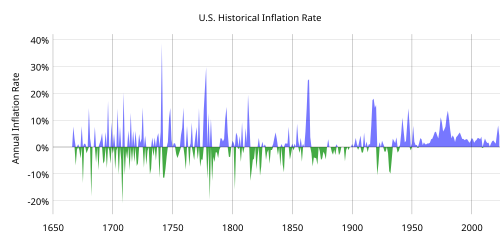
The Great Deflation or the Great Sag refers to the period from 1870 until 1890 in which the world prices of goods, materials and labor decreased, although at a low rate of less than 2% annually.[1] This was one of the few sustained periods of deflationary growth in the history of the United States.[citation needed]
Many businesses suffered, such as warehousing, especially in the London area, due to improvements in transportation, like efficient steam shipping and the opening of the Suez Canal, and also because of the international telegraph network. Displaced workers found new employment in the expanding economy as real incomes grew.[2]
By contrast to the mild deflation of the so-called Great Deflation, the deflation of the 1930s Great Depression was so severe that deflation today is associated with depressions, although economic data suggest this correlation was an outlier.[3]
- ^ Michael Bordo and Angela Redish (2001). "Claremont Conference on Deflation—Canadian Deflations and the Twisting Aggregate Supply Curve" (PDF). Rutgers University and the University of British Columbia. p. 7. Archived from the original (PDF) on 8 September 2006. Retrieved 23 September 2006.
- ^ Wells, David A. (1891). Recent Economic Changes and Their Effect on Production and Distribution of Wealth and Well-Being of Society. New York: D. Appleton and Co. ISBN 0-543-72474-3.
RECENT ECONOMIC CHANGES AND THEIR EFFECT ON DISTRIBUTION OF WEALTH AND WELL BEING OF SOCIETY WELLS.
{{cite book}}: ISBN / Date incompatibility (help) - ^ Andrew Atkeson and Patrick J. Kehoe of the Federal Reserve Bank of Minneapolis Deflation and Depression: Is There an Empirical Link?
© MMXXIII Rich X Search. We shall prevail. All rights reserved. Rich X Search
